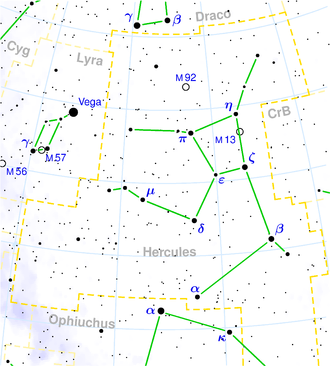NGC 6267
| Galaxy NGC 6267 |
|
|---|---|
![NGC 6267 [1] SDSS image](https://upload.wikimedia.org/wikipedia/commons/thumb/3/31/NGC6267_-_SDSS_DR14.jpg/300px-NGC6267_-_SDSS_DR14.jpg)
|
|
| NGC 6267 SDSS image | |
| AladinLite | |
| Constellation | Hercules |
|
Position equinox : J2000.0 , epoch : J2000.0 |
|
| Right ascension | 16 h 58 m 08.659 s |
| declination | + 22 ° 59 ′ 06.38 ″ |
| Appearance | |
| Morphological type | SB (r) bc |
| Brightness (visual) | 13.3 mag |
| Brightness (B-band) | 14.0 mag |
| Angular expansion | 1.3 ′ × 1.0 ′ |
| Position angle | 35 ° |
| Surface brightness | 13.4 mag / arcmin² |
| Physical data | |
| Affiliation | NGC 6278 group LGG 409 |
| Redshift | 0.009940 ± 0.000007 |
| Radial velocity | 2980 ± 2 km / s |
|
Stroke distance v rad / H 0 |
(139 ± 10) x 10 6 ly (42.7 ± 3.0) Mpc |
| history | |
| discovery | Wilhelm Herschel |
| Discovery date | May 15, 1784 |
| Catalog names | |
| NGC 6267 • UGC 10628 • PGC 59340 • CGCG 139-025 • MCG + 04-40-09 • IRAS 16560 + 2303 • 2MASX J16580867 + 2259062 • GC 4262 • H III 123 • 2MASS J16580865 + 2259064 • HOLM 764A • NSA 147543 • WISEA J165808.66 + 225906.5 | |
NGC 6267 is a 13.3 likes bright barred spiral galaxy of Hubble type SBc in the constellation Hercules at the northern sky . It is estimated to be 139 million light years from the Milky Way and about 50,000 light years across. Together with NGC 6278 it forms the gravitationally bound galaxy pair Holm 765 and is the brightest member of the small NGC 6278 group ( LGG 409 ).
In the same area of the sky are u. a. the galaxies NGC 6276 and IC 4639 .
The object was discovered on May 15, 1784 by Wilhelm Herschel with an 18.7-inch reflector telescope, who described it as "vF, pL, R, lbM".
